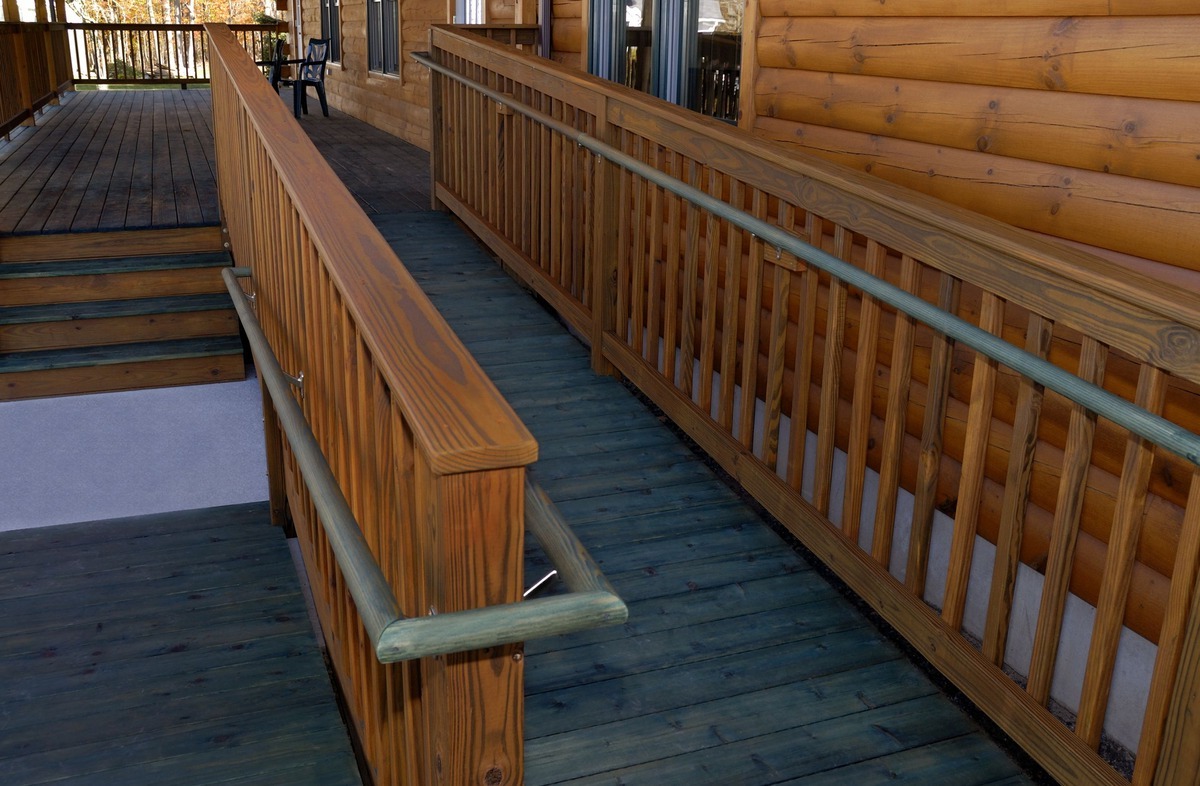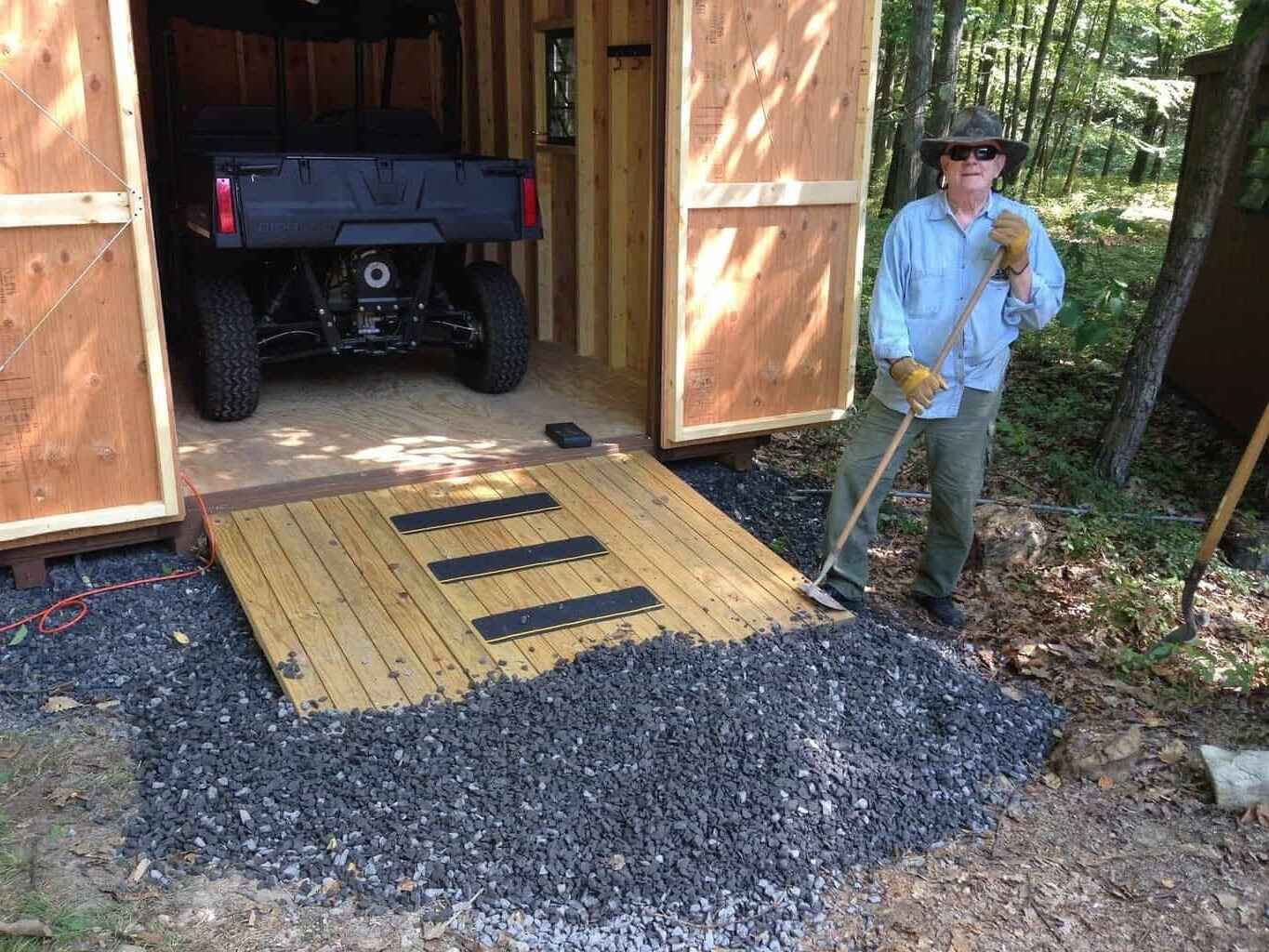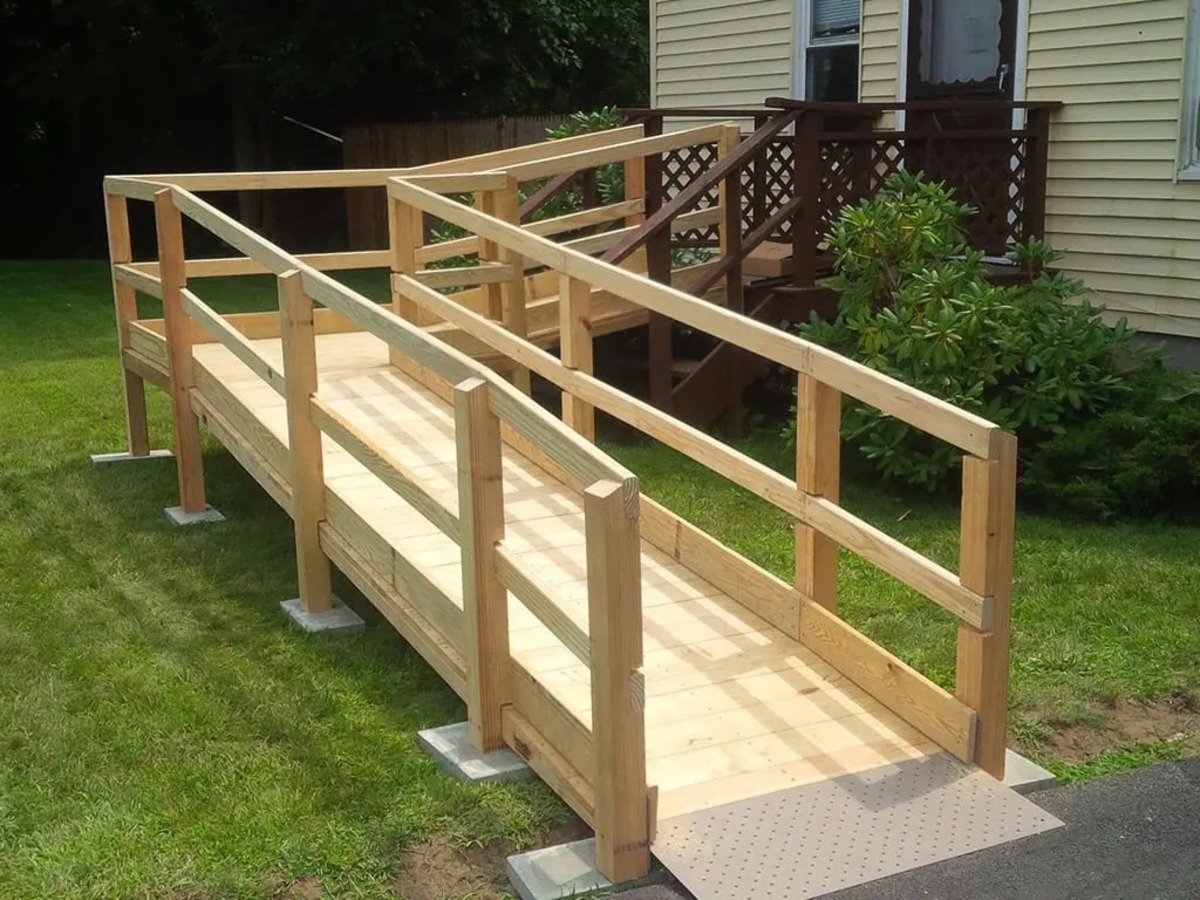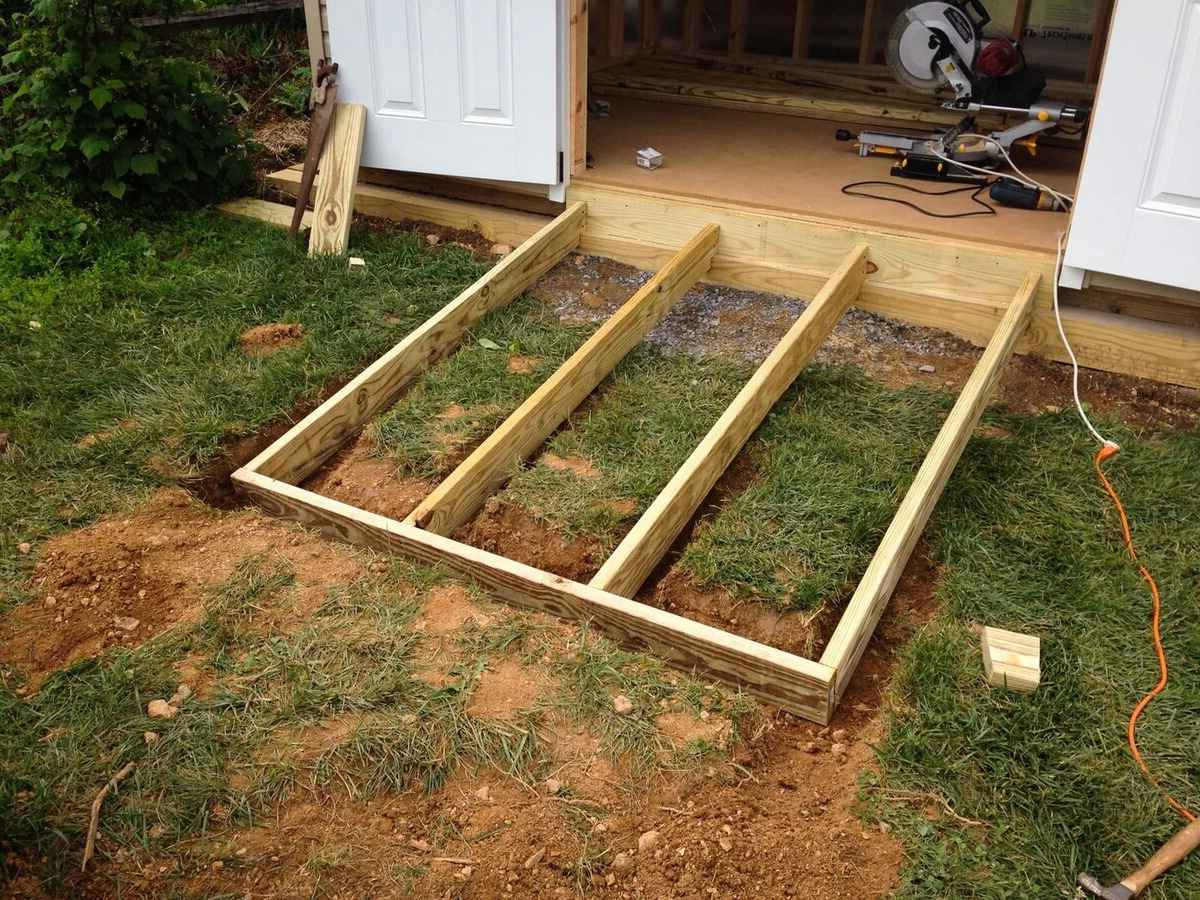Home>Create & Decorate>DIY & Crafts>How To Build A Handicap Ramp


DIY & Crafts
How To Build A Handicap Ramp
Published: February 23, 2024

Content Creator specializing in woodworking and interior transformations. Caegan's guides motivate readers to undertake their own projects, while his custom furniture adds a personal touch.
Learn how to build a handicap ramp with our easy DIY & Crafts guide. Create a safe and accessible entrance for your home with our step-by-step instructions.
(Many of the links in this article redirect to a specific reviewed product. Your purchase of these products through affiliate links helps to generate commission for Twigandthistle.com, at no extra cost. Learn more)
Introduction
Building a handicap ramp is a meaningful and practical project that can significantly improve accessibility for individuals with mobility challenges. Whether it's for your own home, a community center, or a place of business, constructing a well-designed ramp can make a world of difference for those who rely on mobility aids such as wheelchairs, walkers, or scooters.
The process of building a handicap ramp involves careful planning, precise measurements, and attention to safety regulations. It's not just about creating a sloped pathway; it's about ensuring that the ramp meets the specific needs of the individuals who will use it. From assessing the need for a ramp to obtaining permits, designing the structure, and finally, constructing and testing it, each step is crucial to the overall success of the project.
In this comprehensive guide, we will walk through the essential steps of building a handicap ramp, providing practical insights and tips to help you navigate the process with confidence. By the end of this guide, you will have a clear understanding of what it takes to create a safe, functional, and compliant ramp that enhances accessibility for everyone.
Whether you're a homeowner looking to improve your property's accessibility, a business owner aiming to provide equal access to all customers, or a community member dedicated to making public spaces more inclusive, this guide will equip you with the knowledge and guidance needed to embark on this impactful endeavor. So, let's roll up our sleeves and dive into the step-by-step process of building a handicap ramp that makes a positive difference in the lives of others.
Read more: How To Build A Ramp
Step 1: Assessing the Need for a Handicap Ramp
Before embarking on the construction of a handicap ramp, it is crucial to assess the specific requirements and determine the necessity for such a structure. This initial step involves a thoughtful evaluation of the environment and the needs of individuals who will benefit from the ramp.
Understanding Accessibility Challenges
The first consideration in assessing the need for a handicap ramp is to understand the accessibility challenges faced by individuals with mobility limitations. This involves identifying potential barriers such as steps, uneven terrain, or narrow doorways that hinder the smooth movement of individuals using wheelchairs, walkers, or other mobility aids. By recognizing these obstacles, you can gain insight into the critical areas where a ramp would be most beneficial.
Evaluating User Requirements
Next, it's essential to consider the specific needs of the individuals who will utilize the ramp. Factors such as the degree of incline that is manageable for wheelchair users, the width of the ramp to accommodate different mobility devices, and the presence of handrails for stability should all be taken into account. By understanding the unique requirements of potential users, you can tailor the design and construction of the ramp to best meet their needs.
Compliance with Regulations
Assessing the need for a handicap ramp also involves ensuring compliance with local building codes and accessibility regulations. These standards outline specific requirements for ramp slope, width, surface texture, handrail height, and other safety features. By familiarizing yourself with these regulations, you can ensure that the ramp not only meets the needs of users but also adheres to legal requirements, providing a safe and accessible pathway for all.
Read more: How To Build A Ramp For A Shed
Environmental Considerations
Lastly, evaluating the need for a handicap ramp includes considering environmental factors such as weather conditions, the presence of obstacles, and the overall layout of the surrounding area. These elements can influence the design and placement of the ramp, ensuring that it seamlessly integrates with the existing space while providing a smooth and safe transition for individuals with mobility challenges.
By thoroughly assessing the need for a handicap ramp, you can lay a solid foundation for the subsequent steps involved in the construction process. This thoughtful evaluation sets the stage for designing a ramp that not only meets regulatory standards but also addresses the specific accessibility requirements of the individuals it aims to serve.
Step 2: Obtaining Necessary Permits and Permissions
Before commencing the construction of a handicap ramp, it is imperative to obtain the required permits and permissions from the relevant authorities. This crucial step ensures that the ramp project complies with local building codes and regulations while also upholding safety standards.
Research Local Regulations
The first task in obtaining permits and permissions is to research the specific regulations and requirements governing the construction of handicap ramps in your locality. This may involve contacting the local building department or visiting their website to access the necessary information. Understanding the applicable regulations is essential for ensuring that the ramp design and construction align with legal standards.
Permit Application Process
Once familiar with the relevant regulations, the next step is to initiate the permit application process. This typically involves submitting detailed plans and specifications of the proposed ramp to the local building department for review. The plans should outline the dimensions, materials, slope, handrail specifications, and other pertinent details of the ramp. It is important to be thorough and accurate in the submission to expedite the approval process.
Read more: How To Build A Wheelchair Ramp
Engage with Authorities
Engaging in open communication with the building department or relevant authorities is crucial during the permit application process. This may involve seeking clarification on specific requirements, addressing any concerns raised during the review, and ensuring that the proposed ramp meets all necessary criteria. Building a positive rapport with the authorities can facilitate a smoother approval process and help resolve any potential issues efficiently.
Community or HOA Approval
In some cases, if the property is part of a community governed by a homeowners' association (HOA) or similar entity, obtaining approval from the community board may be necessary. This additional step ensures that the ramp project aligns with the community's guidelines and regulations, promoting harmony and compliance within the neighborhood.
Compliance and Documentation
Throughout the permit acquisition process, it is essential to maintain meticulous records of all communications, submissions, and approvals. This documentation serves as a valuable resource, providing evidence of compliance with regulations and permissions obtained. Keeping thorough records also facilitates transparency and accountability throughout the construction phase.
By diligently navigating the process of obtaining necessary permits and permissions, you can lay a solid groundwork for the subsequent stages of designing and constructing the handicap ramp. This proactive approach not only ensures legal compliance but also sets the stage for a smooth and successful implementation of the accessibility project.
Step 3: Designing the Ramp
Designing a handicap ramp is a pivotal phase that demands meticulous attention to detail and a comprehensive understanding of the specific accessibility needs it aims to address. The design process involves translating the assessed requirements and regulatory standards into a well-conceived plan that ensures the ramp is not only functional but also safe and compliant.
Read more: How To Build A Bike Ramp
Consider User Needs and Preferences
The design phase begins with a thorough consideration of the needs and preferences of the individuals who will utilize the ramp. Factors such as the degree of incline that is manageable for wheelchair users, the width of the ramp to accommodate different mobility devices, and the presence of handrails for stability are essential elements to address. Additionally, incorporating user feedback and insights can further enhance the design, ensuring that it resonates with the individuals it serves.
Adhere to Regulatory Standards
Designing the ramp also entails strict adherence to local building codes and accessibility regulations. These standards dictate specific requirements for ramp slope, width, surface texture, handrail specifications, and other safety features. Integrating these regulatory parameters into the design is crucial for ensuring legal compliance and creating a ramp that meets the highest safety standards.
Customization for the Environment
The environmental context in which the ramp will be situated plays a significant role in the design process. Factors such as the layout of the surrounding area, weather conditions, and the presence of obstacles must be carefully considered. Customizing the design to seamlessly integrate with the existing space while addressing environmental challenges ensures that the ramp not only functions effectively but also harmonizes with its surroundings.
Material Selection and Durability
Selecting the appropriate materials for the ramp is a critical aspect of the design phase. The chosen materials should be durable, weather-resistant, and capable of withstanding regular use. Additionally, the surface texture should provide sufficient traction to prevent slips and falls, further emphasizing the importance of material selection in the design process.
Read more: How To Build A Ramp For A Deck
Aesthetics and Integration
While prioritizing functionality and safety, the design of the ramp should also consider aesthetics and integration with the overall environment. A well-designed ramp not only serves its practical purpose but also contributes to the visual appeal of the space. Thoughtful integration of the ramp into the existing architecture and landscape enhances its overall impact and fosters a sense of inclusivity.
By meticulously addressing these aspects in the design phase, you can lay the groundwork for a well-executed construction process that results in a handicap ramp that not only meets the specific accessibility needs but also reflects a thoughtful and comprehensive approach to inclusivity.
Step 4: Gathering Materials and Tools
Gathering the necessary materials and tools is a crucial preparatory step before commencing the construction of a handicap ramp. The selection of high-quality materials and the availability of the right tools are essential for ensuring the structural integrity, durability, and safety of the ramp. Here's a detailed overview of the key components required for this phase:
Materials
-
Lumber: Selecting pressure-treated lumber is essential for withstanding outdoor elements and ensuring the longevity of the ramp. The choice of lumber should align with the design specifications, considering factors such as weight capacity and environmental durability.
-
Hardware: This includes an assortment of screws, bolts, and fasteners designed for outdoor use. Stainless steel or galvanized hardware is recommended to prevent corrosion and maintain the structural integrity of the ramp.
-
Ramp Surface: The surface material should provide sufficient traction to prevent slips and falls. Options include outdoor-grade plywood, composite decking, or non-slip aluminum treads, chosen based on durability and slip resistance.
-
Handrails and Balusters: If the design calls for handrails, selecting sturdy and weather-resistant materials such as metal or PVC is essential. Balusters should be chosen to meet safety standards while complementing the overall design.
-
Concrete: If the ramp requires footings or support posts, concrete will be necessary for their construction. Ensuring the proper mix and reinforcement is crucial for the stability and longevity of these foundational elements.
Tools
-
Measuring and Marking Tools: Tape measures, levels, and chalk lines are essential for accurate measurements and layout markings, ensuring precision during the construction process.
-
Cutting Tools: Circular saws, jigsaws, and miter saws are indispensable for cutting lumber and other materials to the required dimensions, facilitating the assembly of the ramp structure.
-
Fastening Tools: Cordless drills, impact drivers, and screwdrivers are essential for securing the various components of the ramp, providing efficient and reliable fastening.
-
Concrete Tools: If concrete footings are part of the design, tools such as a mixing tub, trowel, and float will be necessary for preparing and finishing the concrete elements.
-
Safety Equipment: Personal protective equipment including gloves, safety glasses, and hearing protection should be readily available to ensure the safety of the construction team throughout the project.
By meticulously gathering the required materials and ensuring the availability of the appropriate tools, you can set the stage for a smooth and efficient construction process, laying the foundation for a well-constructed and durable handicap ramp that meets the specific accessibility needs of its users.
Read more: How To Build A Boat Ramp
Step 5: Building the Ramp
With the meticulous planning and preparation in place, the construction phase marks the tangible realization of the carefully crafted design and the culmination of efforts to enhance accessibility. Building a handicap ramp involves a series of systematic steps that require precision, attention to detail, and a commitment to safety. Here's a comprehensive overview of the key elements involved in the construction of the ramp:
1. Site Preparation
The construction process begins with site preparation, which involves clearing the designated area and ensuring a level foundation for the ramp. Any obstructions or debris that may impede the construction process are removed, and the ground is meticulously leveled to provide a stable base for the ramp structure.
2. Frame Assembly
The assembly of the ramp frame is a critical phase that sets the structural foundation for the entire ramp. This involves cutting and assembling the pressure-treated lumber according to the design specifications, ensuring precise measurements and secure fastening. The frame serves as the framework upon which the ramp surface and handrails will be installed.
3. Surface Installation
Once the frame is in place, the installation of the ramp surface material follows. Whether it's outdoor-grade plywood, composite decking, or non-slip aluminum treads, the surface material is secured to the frame, providing a durable and slip-resistant pathway for individuals with mobility challenges. Attention to detail is crucial during this phase to ensure a smooth and level surface.
Read more: How To Build A Dog Ramp
4. Handrail Construction
If the design includes handrails, the construction of these safety features is the next step. Sturdy and weather-resistant materials such as metal or PVC are utilized to construct the handrails, ensuring compliance with safety standards and providing essential support and stability for ramp users.
5. Finishing Touches
The construction process is rounded off with the addition of finishing touches, which may include the installation of transition plates at the top and bottom of the ramp, ensuring a seamless connection with the existing surfaces. Any necessary adjustments and final inspections are carried out to guarantee the structural integrity and safety of the completed ramp.
By methodically progressing through these construction phases, the vision of an accessible and inclusive environment begins to materialize. Each step is executed with precision and care, culminating in the creation of a well-constructed handicap ramp that not only meets regulatory standards but also reflects a commitment to enhancing accessibility for all.
Step 6: Adding Safety Features
Incorporating robust safety features is a critical aspect of constructing a handicap ramp, ensuring that it not only provides accessibility but also prioritizes the well-being and security of its users. The addition of safety features serves to mitigate potential hazards, enhance stability, and instill confidence in individuals with mobility challenges as they navigate the ramp. Here's a detailed exploration of the key safety features that are integral to the construction of a handicap ramp:
1. Handrails and Guardrails
Handrails and guardrails are fundamental safety components that provide crucial support and guidance for individuals using the ramp. Handrails, typically installed along the sides of the ramp, offer stability and assistance for users as they ascend or descend. These should be positioned at a comfortable height and constructed from durable, graspable materials to ensure reliability and ease of use. Guardrails, on the other hand, serve as protective barriers along the edges of the ramp, preventing accidental falls and enhancing overall safety.
2. Non-Slip Surface
The surface of the ramp should be designed to offer optimal traction, minimizing the risk of slips and falls, particularly in adverse weather conditions. Utilizing non-slip materials such as textured aluminum treads, outdoor-grade plywood with a non-slip coating, or composite decking with a textured surface enhances the grip and stability of the ramp, promoting safe passage for individuals with varying mobility aids.
3. Transition Plates
Transition plates play a vital role in ensuring a seamless connection between the ramp and the adjoining surfaces, such as door thresholds or landings. These plates serve to eliminate potential tripping hazards and provide a smooth transition for wheelchair users and individuals with mobility devices. Additionally, they contribute to the overall safety and accessibility of the ramp by facilitating effortless movement between different levels.
4. Visibility and Lighting
Incorporating adequate visibility and lighting features is essential, particularly for ramps located in dimly lit or nighttime environments. Installing handrail-mounted or pathway lighting enhances visibility and ensures that the ramp remains safely navigable at all times. Clear signage and contrasting colors can also be employed to improve visibility and aid individuals with visual impairments in identifying the ramp's boundaries and potential obstacles.
5. Anti-Slip Coatings
Applying anti-slip coatings to the ramp surface further reinforces its safety features, providing an additional layer of protection against potential hazards. These coatings enhance the traction of the ramp, particularly in wet or icy conditions, reducing the likelihood of accidents and promoting a secure passage for all users.
By integrating these safety features into the construction of the handicap ramp, you can create an environment that not only facilitates accessibility but also prioritizes the safety and well-being of individuals with mobility challenges. These features collectively contribute to the creation of a secure and inclusive pathway, reflecting a commitment to fostering a supportive and accessible space for all.
Read more: How To Make A Wooden Ramp
Step 7: Testing and Adjusting the Ramp
The final phase of building a handicap ramp involves thorough testing and meticulous adjustments to ensure that the completed structure meets the highest standards of safety, functionality, and accessibility. This critical step serves as the ultimate validation of the construction efforts, providing assurance that the ramp is fully equipped to serve individuals with mobility challenges effectively.
Comprehensive Inspection
The testing process begins with a comprehensive inspection of every component of the ramp. This includes scrutinizing the structural integrity of the frame, the stability of handrails and guardrails, the evenness and traction of the surface, and the seamless integration of transition plates. Each element is meticulously evaluated to identify any potential issues that may compromise the safety and usability of the ramp.
Load-Bearing Assessment
Conducting a load-bearing assessment is essential to ascertain the ramp's capacity to support the weight of individuals and mobility devices. This involves subjecting the ramp to varying degrees of weight and stress, simulating real-world usage scenarios. By evaluating the ramp's response to different loads, any weaknesses or structural deficiencies can be identified and addressed, ensuring the ramp's reliability and durability.
Accessibility Testing
Testing the ramp's accessibility involves assessing its usability for individuals with diverse mobility aids, including wheelchairs, walkers, and scooters. This evaluation encompasses maneuverability, incline management, and the ease of navigation. By engaging individuals with mobility challenges in the testing process, valuable feedback can be gathered to refine the ramp's design and address any usability concerns effectively.
Read more: How To Build A Shed Ramp With Pavers
Alignment and Leveling
Ensuring the proper alignment and leveling of the ramp is crucial for promoting smooth and safe passage. Any discrepancies in alignment or uneven surfaces can pose significant challenges for users. Through precise measurements and adjustments, the ramp's alignment is meticulously fine-tuned to guarantee a seamless transition and eliminate potential obstacles or hazards.
Regulatory Compliance Verification
The final testing phase includes a comprehensive verification of the ramp's compliance with local building codes and accessibility regulations. This involves cross-referencing the completed structure with the specified requirements, ensuring that the ramp meets the stipulated standards for slope, width, handrail height, and other safety features. Any deviations are promptly addressed to align with regulatory mandates.
Iterative Adjustments
Throughout the testing process, any identified issues or deficiencies are addressed through iterative adjustments. This may involve reinforcing structural components, refining the surface texture for enhanced traction, or fine-tuning the placement of handrails to optimize usability. Each adjustment is meticulously implemented to elevate the ramp's performance and safety.
By rigorously testing and fine-tuning the completed ramp, you can ensure that it not only meets but exceeds the expectations for safety, functionality, and inclusivity. This meticulous approach underscores a commitment to creating an environment that prioritizes accessibility and fosters a sense of empowerment for individuals with mobility challenges.
Conclusion
In conclusion, the process of building a handicap ramp is a multifaceted endeavor that goes beyond the physical construction of a sloped pathway. It encompasses a thoughtful and comprehensive approach to enhancing accessibility, prioritizing safety, and fostering inclusivity for individuals with mobility challenges. From the initial assessment of the need for a ramp to the meticulous testing and adjustments, each step in the construction process plays a pivotal role in creating a space that is truly accessible to all.
The assessment phase sets the foundation for the entire project, emphasizing the importance of understanding the specific accessibility challenges, user requirements, regulatory compliance, and environmental considerations. This thoughtful evaluation ensures that the subsequent design and construction phases are tailored to meet the unique needs of the individuals who will benefit from the ramp.
Obtaining necessary permits and permissions underscores the commitment to legal compliance and safety, ensuring that the ramp aligns with local building codes and regulations. This proactive approach sets the stage for a construction process that is not only legally sound but also prioritizes the well-being of its users.
The design phase represents the convergence of functionality, safety, and aesthetics, where user needs, regulatory standards, and environmental considerations are seamlessly integrated into a well-conceived plan. This phase lays the groundwork for the subsequent construction, emphasizing the importance of precision and attention to detail.
Gathering the requisite materials and tools and proceeding with the construction phase involves a meticulous execution of the design, culminating in the tangible realization of an accessible pathway. The addition of safety features further reinforces the ramp's usability and security, prioritizing the well-being of individuals with mobility challenges.
The testing and adjustment phase serves as the ultimate validation of the construction efforts, ensuring that the completed ramp meets the highest standards of safety, functionality, and accessibility. This rigorous testing underscores a commitment to creating an environment that prioritizes inclusivity and empowerment for individuals with mobility challenges.
In essence, building a handicap ramp is not just about constructing a physical structure; it is about creating a supportive and inclusive environment that empowers individuals with mobility challenges to navigate spaces with confidence and dignity. By embracing a holistic approach that encompasses assessment, design, construction, safety features, and testing, the construction of a handicap ramp becomes a testament to the commitment to accessibility and inclusivity for all.







